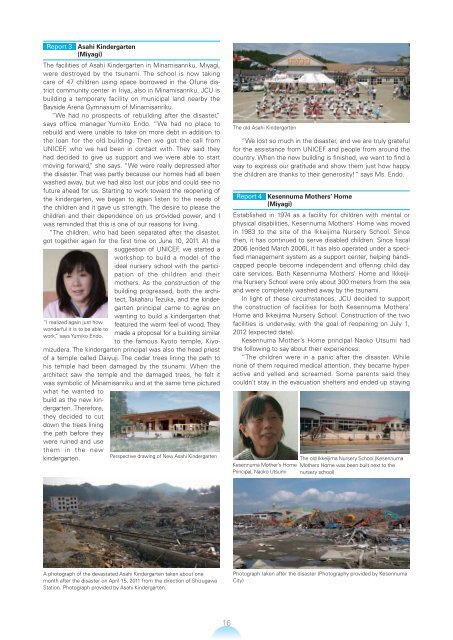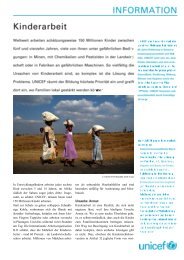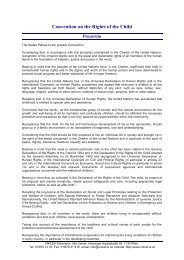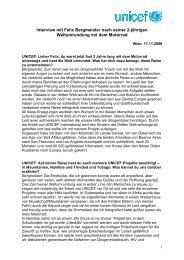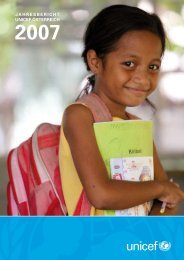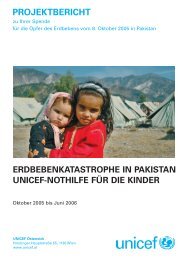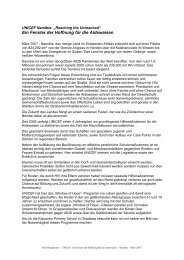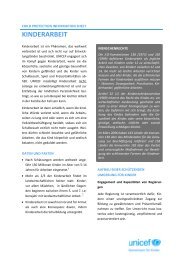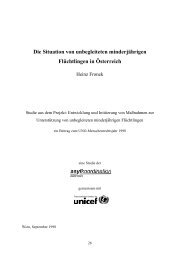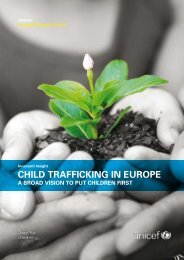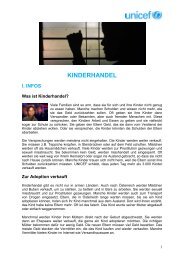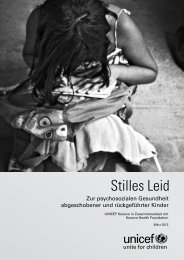Create successful ePaper yourself
Turn your PDF publications into a flip-book with our unique Google optimized e-Paper software.
<strong>Report</strong> 3 Asahi Kindergarten<br />
(Miyagi)<br />
The facilities of Asahi Kindergarten in Minamisanriku, Miyagi,<br />
were destroyed by the tsunami. The school is now taking<br />
care of 47 children using space borrowed in the Ofune district<br />
community center in Iriya, also in Minamisanriku. JCU is<br />
building a temporary facility on municipal land nearby the<br />
Bayside Arena Gymnasium of Minamisanriku.<br />
“We had no prospects of rebuilding after the disaster,”<br />
says office manager Yumiko Endo. “We had no place to<br />
rebuild and were unable to take on more debt in addition to<br />
the loan for the old building. Then we got the call from<br />
UNICEF, who we had been in contact with. They said they<br />
had decided to give us support and we were able to start<br />
moving forward,” she says. “We were really depressed after<br />
the disaster. That was partly because our homes had all been<br />
washed away, but we had also lost our jobs and could see no<br />
future ahead for us. Starting to work toward the reopening of<br />
the kindergarten, we began to again listen to the needs of<br />
the children and it gave us strength. The desire to please the<br />
children and their dependence on us provided power, and I<br />
was reminded that this is one of our reasons for living.<br />
“The children, who had been separated after the disaster,<br />
got together again for the first time on June 10, 2011. At the<br />
suggestion of UNICEF, we started a<br />
workshop to build a model of the<br />
ideal nursery school with the participation<br />
of the children and their<br />
mothers. As the construction of the<br />
building progressed, both the architect,<br />
Takaharu Tezuka, and the kindergarten<br />
principal came to agree on<br />
“I realized again just how<br />
wonderful it is to be able to<br />
work,” says Yumiko Endo.<br />
wanting to build a kindergarten that<br />
featured the warm feel of wood. They<br />
made a proposal for a building similar<br />
to the famous Kyoto temple, Kiyo-<br />
mizudera. The kindergarten principal was also the head priest<br />
of a temple called Daiyuji. The cedar trees lining the path to<br />
his temple had been damaged by the tsunami. When the<br />
architect saw the temple and the damaged trees, he felt it<br />
was symbolic of Minamisanriku and at the same time pictured<br />
what he wanted to<br />
build as the new kindergarten.<br />
Therefore,<br />
they decided to cut<br />
down the trees lining<br />
the path before they<br />
were ruined and use<br />
them in the new<br />
kindergarten.<br />
Perspective drawing of New Asahi Kindergarten<br />
A photograph of the devastated Asahi Kindergarten taken about one<br />
month after the disaster on April 15, 2011 from the direction of Shizugawa<br />
Station. Photograph provided by Asahi Kindergarten.<br />
16<br />
The old Asahi Kindergarten<br />
“We lost so much in the disaster, and we are truly grateful<br />
for the assistance from UNICEF and people from around the<br />
country. When the new building is finished, we want to find a<br />
way to express our gratitude and show them just how happy<br />
the children are thanks to their generosity!” says Ms. Endo.<br />
<strong>Report</strong> 4 Kesennuma Mothers’ Home<br />
(Miyagi)<br />
Established in 1974 as a facility for children with mental or<br />
physical disabilities, Kesennuma Mothers’ Home was moved<br />
in 1983 to the site of the Ikkeijima Nursery School. Since<br />
then, it has continued to serve disabled children. Since fiscal<br />
2006 (ended March 2006), it has also operated under a specified<br />
management system as a support center, helping handicapped<br />
people become independent and offering child day<br />
care services. Both Kesennuma Mothers’ Home and Ikkeijima<br />
Nursery School were only about 300 meters from the sea<br />
and were completely washed away by the tsunami.<br />
In light of these circumstances, JCU decided to support<br />
the construction of facilities for both Kesennuma Mothers’<br />
Home and Ikkeijima Nursery School. Construction of the two<br />
facilities is underway, with the goal of reopening on July 1,<br />
2012 (expected date).<br />
Kesennuma Mother’s Home principal Naoko Utsumi had<br />
the following to say about their experiences.<br />
“The children were in a panic after the disaster. While<br />
none of them required medical attention, they became hyperactive<br />
and yelled and screamed. Some parents said they<br />
couldn’t stay in the evacuation shelters and ended up staying<br />
Kesennuma Mother’s Home<br />
Principal, Naoko Utsumi<br />
The old Ikkeijima Nursery School (Kesennuma<br />
Mothers Home was been built next to the<br />
nursery school)<br />
Photograph taken after the disaster (Photography provided by Kesennuma<br />
City)


